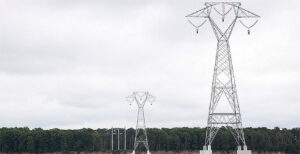
Two of seventeen towers supporting the new 500kv transmission line across the James River, paid for through Rider T on your bills. Dominion photo.
Electricity bills for Dominion Energy Virginia customers jump again in September – almost $7 monthly for a residential customer using 1000 kilowatt hours – as it begins to collect on $845 million in transmission system investments over the past year. A similar level of investment is planned for next year.
The rate hike will appear on the bills in the transmission charge, Rider T, following approval of the annual Rider T update by the State Corporation Commission July 25. The final order is here.
Dominion plans to collect about $922 million for the transmission piece of its operations during the 12 months starting September 1. That is almost $300 million more than it was approved to collect during the 2018-2019 cycle. The utility brings a request for Rider T revenue requirement to the SCC every year, and part of the increase for this year is a “true-up” adjustment for the prior year.
Much of this cost is determined by the regional transmission organization PJM Interconnection LLC, which plans and operates the main grid for its member utilities and allocates costs among them. Not all the higher charges for Rider T are for projects within Dominion’s territory.
Last year’s case was contentious, with the utility under fire at the SCC for failing to adjust its projected tax payment downward to reflect the new lower federal corporate income tax rate. There was also a dispute as Dominion and its customers argued over how to account for certain payments back from the regional transmission organization PJM Interconnection LLC.
The SCC decided both of those disputes in the customer’s favor, and the utility abided by both of those decisions in calculating this latest version of the Rider T charge. There were no major disputes in this case, although the Office of the Attorney General did take note of the substantial cost increase it causes and may cause again in 12 months.
“I don’t recall any cases with this Company where in a single case the residential bill of 1,000 kilowatt hours is going up almost $7 in a single filing. And as we heard from (Dominion’s witness), the … [$]845 million plant additions this year is not an aberration. He testified he expected about that much next year,” Consumer Counsel Meade Browder said at the hearing, a quote picked up by the SCC hearing examiner in his report.
The investments are outside the scope of the still-awaited utility grid modification plan and include projects to place some transmission lines underground and at least some of the cost for the new 500 kilovolt line across the James River. So customers will start pay for its construction and use (including profit) while environmentalists and other activists fight a post-construction battle to have it dismantled. Should that succeed, any costs for dismantling it and funding another alternative would likely fall on ratepayers, as well.


